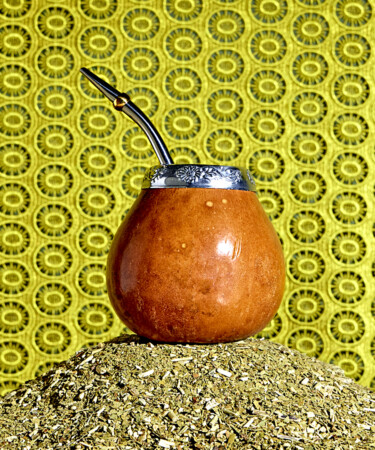If you’ve noticed a lot of yellow cans around lately, you’re not alone: Yerba mate drinks are now everywhere, it seems. The caffeinated beverage, which has been making the rounds in wellness aisles and on social media for years, has emerged right alongside matcha as a “healthier” alternative to coffee. BevNet reported that between May 2020 and May 2021 alone, ready-to-drink yerba mate drinks grew 20.8 percent.
A long-running list of yerba mate’s purported benefits includes enhanced focus, boosted energy, reduced cholesterol, and a super-dose of antioxidants. But many of these fizzy canned drinks also fail to recognize the cultural context of yerba mate, which has been used by South America’s indigenous people for centuries. California-based entrepreneur Gabriela Simoni, originally from Argentina, also noticed the proliferation of canned and bottled yerba mate beverages. So, in 2018, she started a cafe and materia called Mate Conmigo in Northridge, Calif.
“She saw the yellow cans everywhere and thought ‘That’s not the traditional way to drink it,’” says her son and co-owner Juan Carrasco. “It’s kind of unfortunate that people only know the cans.”
What is yerba mate?
Yerba mate —often shortened to mate — is a tree in the holly family, which is native to South America. Its earliest history with humans is as a ceremonial drink of the Guarani people, indigenous to what is now known as Paraguay. Colonizing Jesuits saw commercial potential for mate (pronounced mah-tay) and spread it around the continent. It is now a daily beverage for much of Paraguay, Uruguay, Argentina, and southern Brazil.
What does yerba mate taste like?
Mate will generally taste earthy and vegetal, with a signature bitter finish. How it’s harvested and prepared, though, may change up its flavor profile. The cutting and processing of mate depends on the company sourcing it: It may be allowed to air dry, while sometimes it’s dried with wood smoke, which imparts a smoky flavor to the final beverage. It can be cured anywhere from one to 24 months, allowing it to develop richer flavor and color.
Is yerba mate caffeinated?
Mate is one of the more caffeinated beverages on the spectrum. While caffeine levels depend on the preparation and cultivar, says Carrasco, “we generally say it’s about double the amount of matcha and a bit less than brewed coffee.”
While it may pack less of a punch than your typical morning joe, it can still make a worthy substitute for those looking to lessen their coffee intake. “Most people don’t get the same crash with mate that they would with coffee,” Carrasco explains.
How can yerba be enjoyed traditionally?
There are several different traditional ways to prepare mate, says Carrasco, and people have strong opinions on which ways are correct. Simoni prepared mate on camera for CNN Español in 2019, and caused somewhat of an uproar with her method of choice, laughs Carrasco. Something that can be confusing to English speakers: Mate is also the name of the gourd that brewed yerba mate is traditionally enjoyed out of. (The word “yerba” alone means herb or grass, and can also be a term for cannabis.) A by-the-book vessel would be made out of this gourd or wood, but modern versions can be made of silicone, metal, or glass. Carrasco recommends silicone or glass for folks new to mate, as the wooden or gourd versions need to be cured before use and can crack if they’re not being used often.
Also crucial, explains Carrasco, is the bombilla, a metal straw with a filter at the bottom that allows you to sip directly from the mate without getting plant material in your mouth. These come in various sizes, and different countries have different preferences.
Perhaps the most important aspect of mate, says Carrasco, is that it’s communal. In areas where mate is popular, coffee is enjoyed at breakfast, and then mate is generally for later in the day with other people.
“I see memes on my social media about how if you’re drinking your mate by yourself, something’s gone wrong in your life,” he says. He also cites an Argentine movie in which the parents of a teenager are concerned for him because he drinks his mate alone. Gatherings are planned around mate, and the person who prepares and shares the mate is called the cebador. The way you prepare your mate is a point of pride, and everyone drinks from the same mate and the same bombilla. Some prefer their mate sweet, in which case there will be a second, sweetened mate passed around.
“I went to university in Argentina and we’d make mate and pass it around, including to the professor while he was lecturing,” says Carrasco. “You might get extra points if you’d made a good mate.” Mate also might be passed around at the afternoon snack time, called the merienda.
How to make yerba mate at home
Though it’s more traditional to enjoy mate with a group, Carrasco gives blanket permission for those hoping to enjoy it at home solo. If you’re not ready to run out and purchase your own mate and bombilla, you can use a mug and loose leaf tea strainer.
“In that case, you’d want to follow the preparation instructions on the package,” he says, especially given the range of processing methods. Brand-wise, he recommends Playadito, Cruz de Malta, Rosamonte, and Nobleza Gaucha.
Just make sure not to use boiling water, he says, which can bring out extra bitterness in the mate: “Keep the water between 175 and 180 degrees.” Add sweetener and milk to taste, he adds, and feel free to experiment with iced versions.
